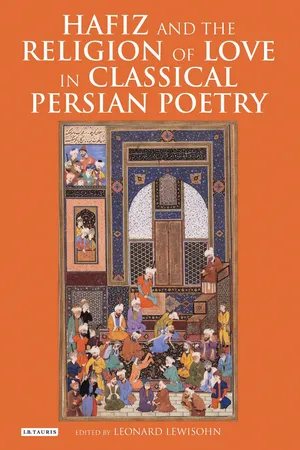
- 360 pages
- English
- ePUB (mobile friendly)
- Available on iOS & Android
Hafiz and the Religion of Love in Classical Persian Poetry
About this book
The romantic lyricism of the great Persian poet Hafiz (1315-1390) continues to be admired around the world. Recent exploration of that lyricism by Iranian scholars has revealed that, in addition to his masterful use of poetic devices, Hafiz's verse is deeply steeped in the philosophy and symbolism of Persian love mysticism. This innovative volume discusses the aesthetic theories and mystical philosophy of the classical Persian love-lyric (ghazal) as particularly exemplified by Hafiz (who, along with Rumi and Sa'di, is Persia's most celebrated poet). For the first time in western literature, Hafiz's rhetoric of romance is situated within the broader context of what scholars refer to as 'Love Theory' in Arabic and Persian poetry in particular and Islamic literature more generally. Contributors from both the West and Iran conduct a major investigation of the love lyrics of Hafiz and of what they signified to that high culture and civilization which was devoted to the School of Love in medieval Persia. The volume will have strong appeal to scholars of the Middle East, medieval Islamic literature, and the history and culture of Iran.
Frequently asked questions
- Essential is ideal for learners and professionals who enjoy exploring a wide range of subjects. Access the Essential Library with 800,000+ trusted titles and best-sellers across business, personal growth, and the humanities. Includes unlimited reading time and Standard Read Aloud voice.
- Complete: Perfect for advanced learners and researchers needing full, unrestricted access. Unlock 1.4M+ books across hundreds of subjects, including academic and specialized titles. The Complete Plan also includes advanced features like Premium Read Aloud and Research Assistant.
Please note we cannot support devices running on iOS 13 and Android 7 or earlier. Learn more about using the app.
Information
PART I
ḤĀFIẒ IN THE SOCIO-HISTORICAL, LITERARY AND MYSTICAL MILIEU OF MEDIEVAL PERSIA
Prolegomenon to the Study of Ḥāfiẓ
1 – Socio-historical and Literary Contexts: Ḥāfiẓ in Shīrāz
Table of contents
- Cover
- Author biography
- Title Page
- INTERNATIONAL LIBRARY OF IRANIAN STUDIES
- Epigraph
- Copyright Page
- Contents
- List of Contributors
- List of Plates
- Foreword: Hāfiz of Shīrāz
- Editor’s Introduction and Acknowledgements
- PART I HĀFIZ IN THE SOCIO-HISTORICAL, LITERARY AND MYSTICAL MILIEU OF MEDIEVAL PERSIA
- Prolegomenon to the Study of Hāfiz
- 1 – Socio-historical and Literary Contexts: Hāfiz in Shīrāz
- 2 – The Mystical Milieu: Hāfiz’s Erotic Spirituality
- PART II HĀFIZ AND THE SCHOOL OF LOVE IN CLASSICAL PERSIAN POETRY
- The Principles of the Religion of Love in Classical Persian Poetry
- The Erotic Spirit: Love, Man and Satan in Hāfiz’s Poetry
- The Radiance of Epiphany: The Vision of Beauty and Love in Hāfiz’s Poem of Pre-Eternity
- PART III HĀFIZ AND THE PERSIAN SUFI TRADITION
- Hāfiz and the Sufi
- The Religion of Love and the Puritans of Islam: Sufi Sources of Hāfiz’s Anti-clericalism
- Jalāl al-Dīn Davānī’s Interpretation of Hāfiz
- PART IV HĀFIZ’S ROMANTIC IMAGERY AND LANGUAGE OF LOVE
- The Allegory of Drunkenness and the Theophany of the Beloved in Sixteenth-Century Illustrations of Hāfiz
- Transfiguring Love: Perspective Shifts and the Contextualization of Experience in the Ghazals of Hāfiz
- The Semiotic Horizons of Dawn in the Poetry of Hāfiz
- Hāfiz and the Language of Love in Nineteenth-Century English and American Poetry
- Bibliography
- Plates